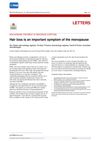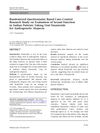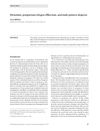Androgenetic Alopecia in Women
January 2007
in “
Revista del Centro Dermatológico Pascua
”

TLDR Hair loss in women, often not related to male hormones, increases with age and can cause significant emotional distress.
The 2007 document discusses androgenetic alopecia (AGA) in women, a common form of hair loss characterized by the replacement of terminal hairs with fine vellus hairs, which is not necessarily androgen-dependent as it is in men. It affects over 30% of women by the end of life, with incidence increasing after age 20 and peaking at 50. The main event in AGA is follicular miniaturization, with a shortened anagen phase but an unchanged telogen phase. AGA is influenced by genetic, hormonal, and environmental factors, and may involve an inflammatory process. Women typically experience diffuse thinning in the fronto-parietal region while maintaining the frontal hairline, and severity is graded using the Ludwig classification. Diagnosis is clinical, and treatments include topical minoxidil, oral finasteride, and hair transplantation. Psychological distress is significant in affected women, who may require support. Antiandrogens and finasteride have shown benefits in some cases. The prevalence of personality disorders is higher in individuals with AGA, but this is not observed in women with the condition.







